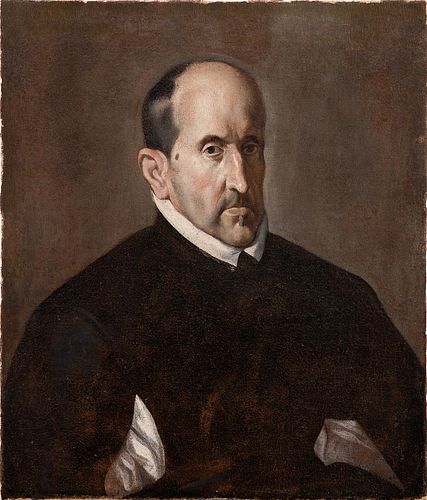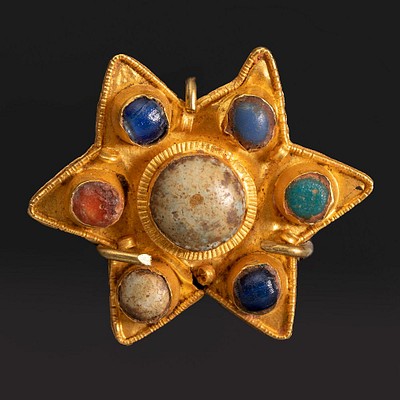Spanish master; 17th century. "Portrait of Luis de Góngora". Oil on canvas.
Lot 83
About Seller
Setdart Auction House
Carrer Aragó 346
Barcelona
Spain
Setdart Subastas was born in 2004 and is currently the first online art auction in Spain with solidity, prestige and reliability guaranteed by our more than 60,000 users. Setdart has a young, dynamic and enterprising team ready to successfully manage the purchase and sale of art works through custom...Read more
Estimate:
EUR€180,000 - EUR€210,000
$193,548.39 - $225,806.45
Absentee vs Live bid
Two ways to bid:
- Leave a max absentee bid and the platform will bid on your behalf up to your maximum bid during the live auction.
- Bid live during the auction and your bids will be submitted real-time to the auctioneer.
Bid Increments
| Price | Bid Increment |
|---|---|
| EUR€0 | EUR€10 |
| EUR€200 | EUR€25 |
| EUR€500 | EUR€50 |
| EUR€1,000 | EUR€100 |
| EUR€3,000 | EUR€200 |
| EUR€5,000 | EUR€500 |
| EUR€10,000 | EUR€1,000 |
| EUR€20,000 | EUR€2,000 |
| EUR€50,000 | EUR€5,000 |
About Auction
By Setdart Auction House
Dec 21, 2021
Set Reminder
2021-12-21 07:30:00
2021-12-21 07:30:00
America/New_York
Bidsquare
Bidsquare : Córdoba: 2,000 Years of Art
https://www.bidsquare.com/auctions/setdart-auction-house/c-rdoba-2-000-years-of-art-8049
Setdart Auction House sofia@setdart.com
Setdart Auction House sofia@setdart.com
- Lot Description
Spanish master; 17th century. "Portrait of Luis de Góngora". Oil on canvas. It retains its original canvas, has repainting, restorations, extensions on the sides and new frame. Provenance: Ramón Aras Jauregui, Gandarillas Collection, Rojas Pavon Córdova, Argote Family. Measurements: 61,5 x 52,5 cm. "You steal my bulk and, when more it owes to your brush, twice pilgrim, of vivacious spirit the brief linen, in the colors that thirsty drinks, vain ashes to the brief linen, that emulates the mud I imagine it, to whom, already ethereal it was, already divine, life entrusted him mute slight splendor. Gentle Belgian, noble theft continues; that fire will personate its matter, and time ignores its texture; whoever sees more, whoever hears more, lasts less". In 1620, Góngora dedicated this sonnet to the painter Juan Van der Hamen (1596-1631), who had painted a portrait of the writer. This relationship between literature and painting experienced great splendor during the Spanish Golden Age, bringing different artistic areas closer than ever before. The recognition of the liberal arts, during the 1600s, led to the development of portrait painting, generating a great interest in the pictorial capture of emblematic figures belonging to the world of literature. For this reason, aristocrats of the time, such as the Count of Arcos, expanded the collections of portraits of illustrious men, with the presence of relevant characters for culture. The preeminence that the figure of the literary figure reached as a famous man is shown by the great proliferation of portraits of Luis de Góngora, who had been defined as the prince of the lyric poets. Several collections housed a portrait of the poet, such as that of the aforementioned painter Juan Van der Hamen, Pedro Vallejo, or the painter Francisco Palomino. In fact, this particular piece bears a great similarity to the portrait of Velázquez painted in 1622, which belongs to the Museo del Padre in Madrid, as well as to two other portraits of the poet, linked to Velázquez, which can be seen in the Museo Lázaro Galdiano and the Museum of Fine Arts in Boston. These portraits, as well as the present one, were probably based on a drawing by Góngora, which Francisco Pachecho requested from his son-in-law Velázquez in 1622. With the intention of adding to the book he had been preparing since 1599, "Libro de descripción de verdaderos retratos de ilustres y memorables varones" (Book of descriptions of true portraits of illustrious and memorable men). These aesthetic similarities led to the fact that this particular work was previously linked to Velázquez's pictorial workmanship. This attribution is reflected in the article by Enrique Romero de Torres, director of the Museum of Fine Arts of Cordoba, who in his article "A portrait of Góngora, painted by Velázquez", a study in which a whole research about the origin of the work is exposed. However, the brushstroke, or the use of white lead, which is imposed on the flesh tones of the face as expressive flashes, providing a great liveliness, link the piece with the work of the artist Antonio del Castillo y Saavedra (1616-1668), a painter from Cordoba who had a close relationship with literature, being awarded on several occasions for his poems. The fame and quality of his work earned him important commissions, including religious altarpieces, portraits and medium-sized series. He was also the teacher of outstanding Cordovan painters of the following generation, such as Juan de Alfaro y Gámez, who in turn received a great aesthetic influence from the work of Diego Velázquez.
- Shipping Info
-
In-house shipping available. Please inquire at admin@setdart.com.
-
- Buyer's Premium



 EUR
EUR CAD
CAD AUD
AUD GBP
GBP MXN
MXN HKD
HKD CNY
CNY MYR
MYR SEK
SEK SGD
SGD CHF
CHF THB
THB















